ABS PORSCHE CAYNNE 2008 1.G Information Manual
[x] Cancel search | Manufacturer: PORSCHE, Model Year: 2008, Model line: CAYENNE, Model: PORSCHE CAYENNE 2008 1.GPages: 95, PDF Size: 3.37 MB
Page 11 of 95
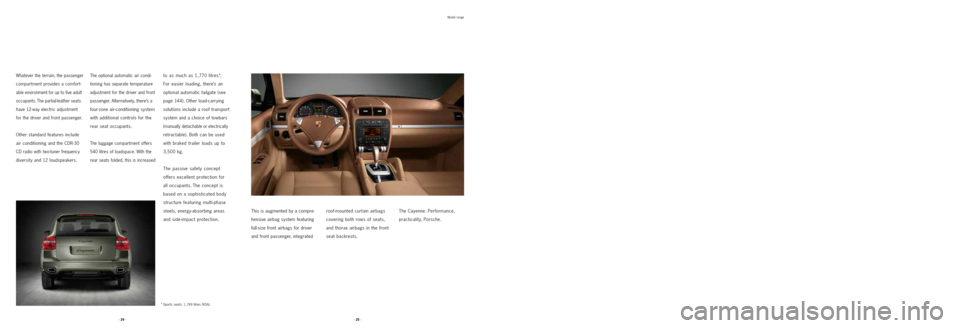
Whatever the terrain, the passenger
compartment provides a comfort-
able environment for up to five adult
occupants. The partial-leather seats
have 12-way electric adjustment
for the driver and front passenger.
Other standard features include
air conditioning and the CDR-30
CD radio with two-tuner frequency
diversity and 12 loudspeakers.
The optional automatic air condi-
tioning has separate temperature
adjustment for the driver and front
passenger. Alternatively, there’s a
four-zone air-conditioning system
with additional controls for the
rear seat occupants.
The luggage compartment offers
540 litres of loadspace. With the
rear seats folded, this is increased
to as much as 1,770 litres*.
For easier loading, there’s an
optional automatic tailgate (see
page 144). Other load-carrying
solutions include a roof transport
system and a choice of towbars
(manually detachable or electrically
retractable). Both can be used
with braked trailer loads up to
3,500 kg.
The passive safety concept
offers excellent protection for
all occupants. The concept is
based on a sophisticated body
structure featuring multi-phase
steels, energy-absorbing areas
and side-impact protection.
This is augmented by a compre-
hensive airbag system featuring
full-size front airbags for driver
and front passenger, integratedroof-mounted curtain airbags
covering both rows of seats,
and thorax airbags in the front
seat backrests.The Cayenne. Performance,
practicality, Porsche.
Model range
· 25 · · 24 ·* Sports seats: 1,749 litres (VDA).
Page 26 of 95

There is one fuel that will always be free.
Which is why we make the most of it.
Air intake system.
The Cayenne models are all
equipped with a resonance air
intake system. This simple
technology uses the pressure
waves generated by the inlet
valves to ‘force’ air into the engine.
The effect is enhanced in
the Cayenne, Cayenne S and
Cayenne GTS by a two-stage
intake manifold. This combines all
the benefits of a long intake tube
(higher torque at low rpm) with
those of a shorter length (more
power at higher rpm). On theCayenne GTS, performance is
enhanced by optimised airflow
management in the intake manifold.
Although ‘naturally aspirated’,
the Cayenne, Cayenne S and
Cayenne GTS provide high torque
ratings across the entire engine
speed range.
Drive
Pressure is often the key to performance.
Turbocharging system in the Cayenne Turbo.
The Porsche Turbo is synonymous
with performance, exhilarating
acoustics and the finest engineering.
The Cayenne Turbo has twin
turbocharger units arranged in
parallel. The low-volume intake
pipes combine with short exhaust
manifolds to achieve a rapid,
emphatic response.
Incoming air is passed through a
filter and compressed by the turbine
units. Its temperature is then
reduced in the intercooler system,
which improves cylinder charging
and limits thermal loads on the
engine.
Boost pressure reaches 1.8 bar
(absolute pressure) under full
acceleration from just 2,500 rpm.In normal road driving (part-throttle
mode), the pre-throttle boost
pressure is reduced in order
to
maximise fuel economy. When
the car is driven more assertively,
the
turbines are ‘pre-spun’ so
as to increase the pressure
available. When the throttle is
finally opened, the boost can
be applied immediately.
Both turbo units are cooled by
dedicated circuits from the main
engine cooling system.This solutionprevents oil degradation due to
overheating.
For the driver, the result is
seamless delivery of phenomenal
power and torque.
· 55 · · 54 ·
Page 32 of 95
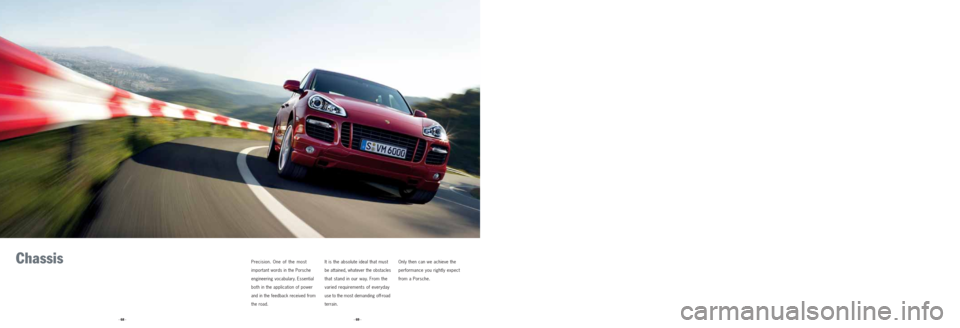
Chassis Precision. One of the most
important words in the Porsche
engineering vocabulary. Essential
both in the application of power
and in the feedback received from
the road.
It is the absolute ideal that must
be attained, whatever the obstacles
that stand in our way. From the
varied requirements of everyday
use to the most demanding off-road
terrain.
Only then can we achieve the
performance you rightly expect
from a Porsche.
· 69 · · 68 ·
Page 40 of 95
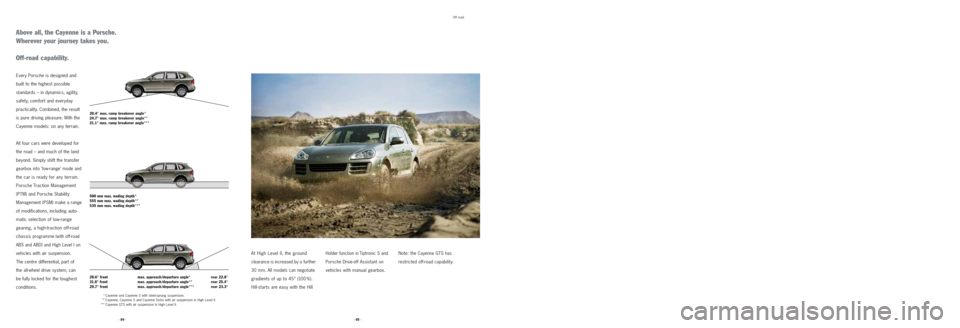
Off road
Every Porsche is designed and
built to the highest possible
standards – in dynamics, agility,
safety, comfort and everyday
practicality. Combined, the result
is pure driving pleasure. With the
Cayenne models: on any terrain.
All four cars were developed for
the road – and much of the land
beyond. Simply shift the transfer
gearbox into ‘low-range’ mode and
the car is ready for any terrain.
Porsche Traction Management
(PTM) and Porsche Stability
Management (PSM) make a range
of modifications, including auto-
matic
selection of low-range
gearing, a high-traction off-road
chassis
programme (with off-road
ABS and
ABD) and High Level I on
vehicles
with air suspension.
The centre differential, part of
the all-wheel drive system, can
be fully locked for the toughest
conditions.At High Level II, the ground
clearance is increased by a further
30 mm. All models can negotiate
gradients of up to 45° (100 %).
Hill-starts are easy with the Hill
Holder function in Tiptronic S and
Porsche Drive-off Assistant on
vehicles with manual gearbox.
28.6° front max. approach /departure angle * rear 22.8°
31.8° front max. approach /departure angle * * rear 25.4°
29.7° front max. approach /departure angle * * * rear 23.3°
20.4° max. ramp breakover angle *
24.7° max. ramp breakover angle * *
21.1° max. ramp breakover angle***
500 mm max. wading depth *
555 mm max. wading depth * *
535 mm max. wading depth * * *
*** Cayenne and Cayenne S with steel-sprung suspension.
*** Cayenne, Cayenne S and Cayenne Turbo with air suspension in High Level II.
*** Cayenne GTS with air suspension in High Level II.
Note: the Cayenne GTS has
restricted off-road capability.
· 85 · · 84 ·
Above all, the Cayenne is a Porsche.
Wherever your journey takes you.
Off-road capability.
Page 47 of 95
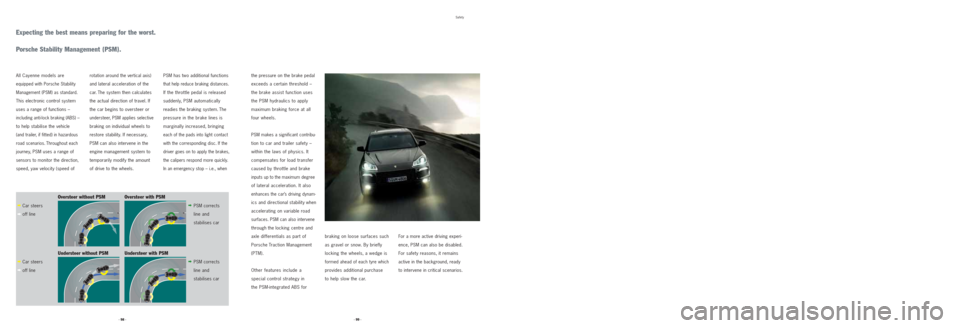
Oversteer with PSM
Understeer without PSM
Car steers
off line Car steers
off line PSM corrects
line and
stabilises car
PSM corrects
line and
stabilises car
Understeer with PSM Oversteer without PSM
All Cayenne models are
equipped with Porsche Stability
Management (PSM) as standard.
This electronic control system
uses a range of functions –
including anti-lock braking (ABS) –
to help stabilise the vehicle
(and trailer, if fitted) in hazardous
road scenarios. Throughout each
journey, PSM uses a range of
sensors to monitor the direction,
speed, yaw velocity (speed of
rotation around the vertical axis)
and lateral acceleration of the
car. The system then calculates
the actual direction of travel. If
the car begins to oversteer or
understeer, PSM applies selective
braking on individual wheels to
restore stability. If necessary,
PSM can also intervene in the
engine management system to
temporarily modify the amount
of drive to the wheels.PSM has two additional functions
that help reduce braking distances.
If the throttle pedal is released
suddenly, PSM automatically
readies the braking system. The
pressure in the brake lines is
marginally increased, bringing
each of the pads into light contact
with the corresponding disc. If the
driver goes on to apply the brakes,
the calipers respond more quickly.
In an emergency stop – i.e., when
the pressure on the brake pedal
exceeds a certain threshold –
the brake assist function uses
the PSM hydraulics to apply
maximum braking force at all
four wheels.
PSM makes a significant contribu-
tion to car and trailer safety –
within the laws of physics. It
compensates for load transfer
caused by throttle and brake
inputs up to the maximum degree
of lateral acceleration. It also
enhances the car’s driving dynam-
ics and directional stability when
accelerating on variable road
surfaces. PSM can also intervene
through the locking centre and
axle differentials as part of
Porsche Traction Management
(PTM).
Other features include a
special control strategy in
the PSM-integrated ABS for braking on loose surfaces such
as gravel or snow. By briefly
locking the wheels, a wedge is
formed ahead of each tyre which
provides additional purchase
to help slow the car.
For a more active driving experi-
ence, PSM can also be disabled.
For safety reasons, it remains
active in the background, ready
to intervene in critical scenarios.
Expecting the best means preparing for the worst.
Porsche Stability Management (PSM).
Safety
· 99 · · 98 ·
Page 48 of 95
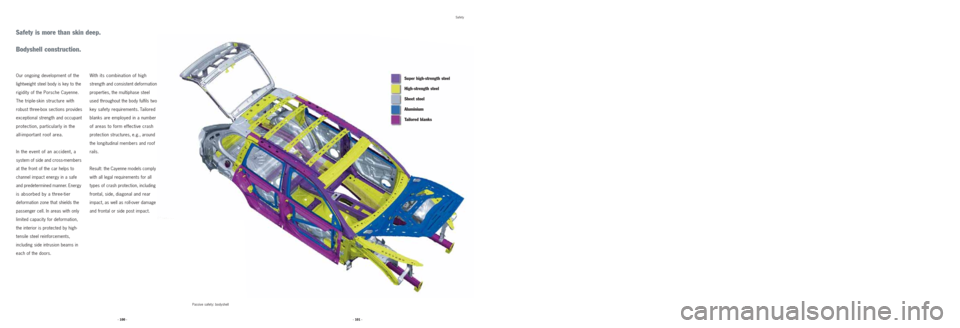
Our ongoing development of the
lightweight steel body is key to the
rigidity of the Porsche Cayenne.
The triple-skin structure with
robust three-box sections provides
exceptional strength and occupant
protection, particularly in the
all-important roof area.
In the event of an accident, a
system of side and cross-members
at the front of the car helps to
channel impact energy in a safe
and predetermined manner. Energy
is absorbed by a three-tier
deformation zone that shields the
passenger
cell. In areas with only
limited capacity for deformation,
the interior is protected by high-
tensile steel reinforcements,
including side intrusion beams in
each of the doors.
Safety is more than skin deep.
Bodyshell construction.
Safety
With its combination of high
strength and consistent deformation
properties, the multiphase steel
used throughout the body fulfils two
key safety requirements. Tailored
blanks are employed in a number
of areas to form effective crash
protection structures, e.g., around
the longitudinal members and roof
rails.
Result: the Cayenne models comply
with all legal requirements for all
types of crash protection, including
frontal, side, diagonal and rear
impact, as well as roll-over damage
and frontal or side post impact.Super high-strength steel
High-strength steel
Sheet steel
Aluminium
Tailored blanks
· 101 · · 100 ·Passive safety: bodyshell
Page 52 of 95
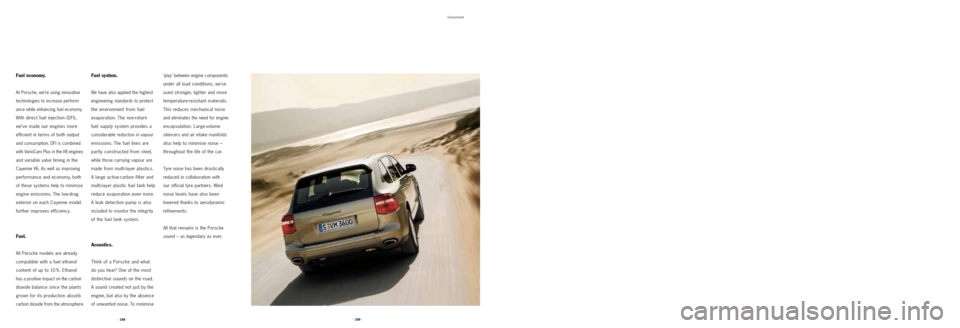
Environment
Fuel system.
We have also applied the highest
engineering standards to protect
the environment from fuel
evaporation. The non-return
fuel supply system provides a
considerable reduction in vapour
emissions. The fuel lines are
partly constructed from steel,
while those carrying vapour are
made from multi-layer plastics.
A large active-carbon filter and
multi-layer plastic fuel tank help
reduce evaporation even more.
A leak detection pump is also
included to monitor the integrity
of the fuel tank system.
Acoustics.
Think of a Porsche and what
do you hear? One of the most
distinctive sounds on the road.
A sound created not just by the
engine, but also by the absence
of unwanted noise. To minimise
Fuel economy.
At Porsche, we’re using innovative
technologies to increase perform-
ance while enhancing fuel economy.
With direct fuel injection (DFI),
we’ve made our engines more
efficient in terms of both output
and consumption. DFI is combined
with VarioCam Plus in the V8 engines
and variable valve timing in the
Cayenne V6. As well as improving
performance and economy, both
of these systems help to minimise
engine emissions. The low-drag
exterior on each Cayenne model
further improves efficiency.
Fuel.
All Porsche models are already
compatible with a fuel ethanol
content of up to 10 %. Ethanol
has a positive impact on the carbon
dioxide balance since the plants
grown for its production absorb
carbon dioxide from the atmosphere.
‘play’ between engine components
under all load conditions, we’ve
used stronger, lighter and more
temperature-resistant materials.
This reduces mechanical noise
and eliminates the need for engine
encapsulation. Large-volume
silencers and air intake manifolds
also help to minimise noise –
throughout the life of the car.
Tyre noise has been drastically
reduced in collaboration with
our official tyre partners. Wind
noise levels have also been
lowered thanks to aerodynamic
refinements.
All that remains is the Porsche
sound – as legendary as ever.
· 109 · · 108 ·
Page 57 of 95
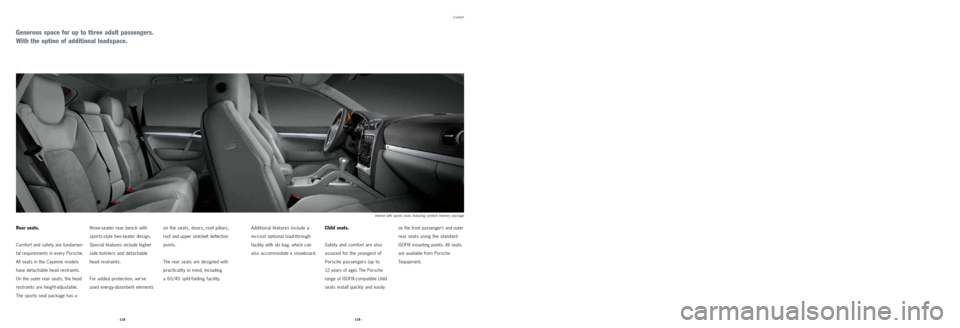
Rear seats.
Comfort and safety are fundamen-
tal requirements in every Porsche.
All seats in the Cayenne models
have detachable head restraints.
On the outer rear seats, the head
restraints are height-adjustable.
The sports seat package has a
three-seater rear bench with
sports-style two-seater design.
Special features include higher
side bolsters and detachable
head restraints.
For added protection, we’ve
used energy-absorbent elements
on the seats, doors, roof pillars,
roof and upper seat-belt deflection
points.
The rear seats are designed with
practicality in mind, including
a 60/40 split-folding facility.Additional features include a
no-cost optional load-through
facility with ski bag, which can
also accommodate a snowboard.
Child seats.
Safety and comfort are also
assured for the youngest of
Porsche passengers (up to
12 years of age). The Porsche
range of ISOFIX-compatible child
seats install quickly and easily
on the front passenger’s and outer
rear seats using the standard
ISOFIX mounting points. All seats
are available from Porsche
Tequipment.
Generous space for up to three adult passengers.
With the option of additional loadspace.
Comfort
Interior with sports seats featuring comfort memory package
· 119 · · 118 ·
Page 90 of 95
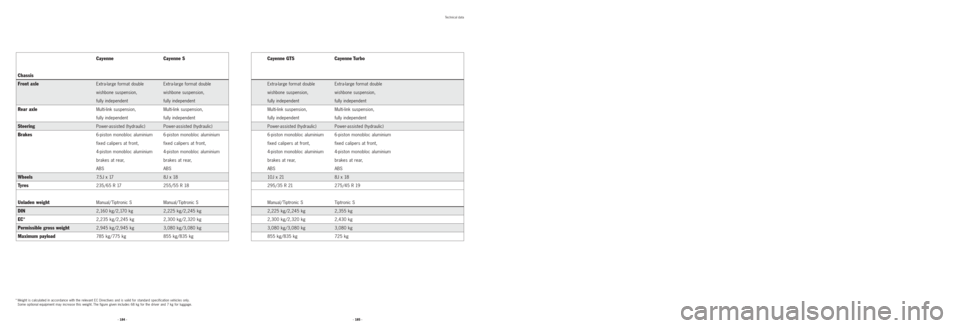
· 185 · · 184 ·
Technical data
* Weight is calculated in accordance with the relevant EC Directives and is valid for standard specification vehicles only.
Some optional equipment may increase this weight. The figure given includes 68 kg for the driver and 7 kg for luggage.
Cayenne Cayenne S
Chassis
Front axle
Extra-large format double Extra-large format double
wishbone suspension, wishbone suspension,
fully independent fully independent
Rear axleMulti-link suspension, Multi-link suspension,
fully independent fully independent
SteeringPower-assisted (hydraulic) Power-assisted (hydraulic)
Brakes6-piston monobloc aluminium 6-piston monobloc aluminium
fixed calipers at front, fixed calipers at front,
4-piston monobloc aluminium 4-piston monobloc aluminium
brakes at rear, brakes at rear,
ABS ABS
Wheels7.5J x 17 8J x 18
Ty r e s235/65 R 17 255/55 R 18
Unladen weightManual/ Tiptronic SManual/ Tiptronic S
DIN2,160 kg/2,170 kg 2,225 kg/2,245 kg
EC*2,235 kg/2,245 kg 2,300 kg/2,320 kg
Permissible gross weight2,945 kg/2,945 kg 3,080 kg/3,080 kg
Maximum payload785 kg/775 kg 855 kg/835 kg
Cayenne GTS Cayenne Turbo
Extra-large format double Extra-large format double
wishbone suspension, wishbone suspension,
fully independent fully independent
Multi-link suspension, Multi-link suspension,
fully independent fully independent
Power-assisted (hydraulic) Power-assisted (hydraulic)
6-piston monobloc aluminium 6-piston monobloc aluminium
fixed calipers at front, fixed calipers at front,
4-piston monobloc aluminium 4-piston monobloc aluminium
brakes at rear, brakes at rear,
ABS ABS
10J x 21 8J x 18
295/35 R 21 275/45 R 19
Manual/ Tiptronic S Tiptronic S
2,225 kg/2,245 kg 2,355 kg
2,300 kg/2,320 kg 2,430 kg
3,080 kg/3,080 kg 3,080 kg
855 kg/835 kg 725 kg